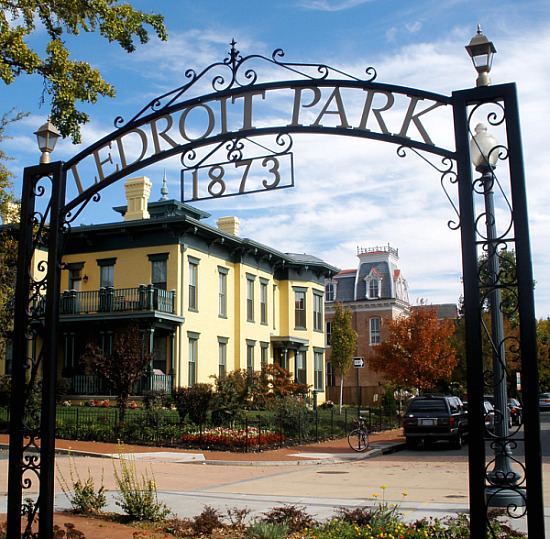NRHP Reference # 74002165 Added to NRHP 25 February 1974 | Year built 1873 | |
 | ||
Location Bounded roughly by Florida, Georgia, and Rhode Island Avenues, 2nd and Elm Streets, NW, Howard University, Washington, D.C. Restaurants Thai X‑ing, The Royal, Pizzarro, Bistro Med Pizza, HalfSmoke | ||
weinyurhooddmv ledroit park westside 2 300 blk uptown dc
LeDroit Park (/ləˈdrɔɪt/ or /ˈliːdrɔɪt/) is a neighborhood in Washington, D.C. located immediately southeast of Howard University. Its borders include W Street to the north, Rhode Island Avenue and Florida Avenue to the south, Second Street NW to the east, and Howard University to the west. LeDroit Park is known for its history and 19th century protected architecture. The community's diversity entices new residents to the community, as well as its close proximity to the Shaw–Howard University Metro station and many dining options.
Contents
- weinyurhooddmv ledroit park westside 2 300 blk uptown dc
- Map of Le Droit Park Washington DC 20001 USA
- Antt frm 640 vs sheen frm ledroit park uptown fight
- History
- Historic District
- Heritage Trail
- Architecture
- Public spaces and art
- Notable residents
- References
Map of Le Droit Park, Washington, DC 20001, USA
Antt frm 640 vs sheen frm ledroit park uptown fight
History
The neighborhood was founded in 1873 by Amzi Barber, a businessman who served on the board of trustees of neighboring Howard University. Barber named the neighborhood after his father-in-law, LeDroict Langdon, but dropped the ⟨c⟩.
As one of the first suburbs of Washington, LeDroit Park was developed and marketed as a "romantic" neighborhood with narrow tree-lined streets that bore the same names as the trees that shaded them, differing from the street names used in the rest of the city. Extensive focus was placed on the landscaping of this neighborhood, as developers spent a large sum of money to plant flower beds and trees to attract high-profile professionals from the city. Originally a whites-only neighborhood, LeDroit Park was even gated with guards to promote security for its residents. Efforts by many, especially multiple actions by students from Howard University, led to the integration of the area. In July 1888 students tore down the fences that separated the neighborhood in protest of its discriminating policies.
By the 1940s LeDroit Park became a major focal point for the African-American elite as many prominent figures resided there. Griffith Stadium, the home of the Washington Redskins and Washington Senators was also located here until 1965, when the Howard University Hospital was built where it used to stand. Le Droit Park includes Anna J. Cooper Circle, named for the education pioneer.
Historic District
Today, the neighborhood's historic value is officially recognized as the LeDroit Park Historic District. The historic district includes the Mary Church Terrell House, a U.S. National Historic Landmark. The neighborhood was awarded a place on the National Register of Historic Places in 1974.
Heritage Trail
On October 17, 2015 the LeDroit Park Heritage Trail was opened. Featuring 16 signs, the 90-minute walking tour chronicles the history of the neighbborhood and its residents. The Trail begins where Florida Avenue, 6th and T Streets, NW meet at the “gateway” to LeDroit Park.
Architecture
One of LeDroit's most recognizable features is its Victorian mansions, houses and row-houses, designed by architect James McGill. None of the original 64 homes McGill designed in LeDroit Park were identical and most were built between 1873 and 1877. Today, 50 of the original homes remain. McGill was also a member of the LeDroit Park Property Owners Association, a precursor to the LeDroit Park Civic Association, which is active today. LeDroit's protected housing stock includes 12 different styles of homes.
Public spaces and art
When the Gage-Eckington School Elementary School closed, residents successfully lobbied the city to tear it down and convert it into a park, which opened in 2011 as The Park at LeDroit. The park houses a large playground, a dog park and the Common Good City Farm, an urban agriculture education center and community garden with 40 plots. In May 2011, His Royal Highness Prince Charles of Wales visited the Common Good City Farm.
Murals are painted on many walls throughout the neighborhood. In the Park at LeDroit, "This is How We Live" was commissioned by the DC Commission on the Arts & Humanities to be painted by artist Garin Baker. The mural shows the African-American heritage of the neighborhood, the changing community and landscape and historical and architectural scenes from the past and present. At the dedication on December 13, 2008, Mayor Adrian M. Fenty is quoted as describing the mural as serving to
...visually engage residents through a beautiful neighborhood mural that depicts the unique landscapes, people and images of the historic LeDroit Park community. The mural will become a prominent landmark in the neighborhood for years to come.
